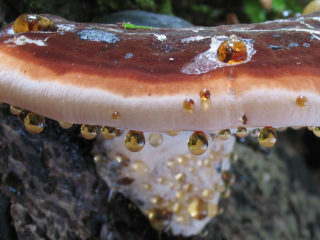Content
Hartig's polypore is a tree fungus of the Hymenochaetae family. Belongs to the category of perennial species. It received its name in honor of the German botanist Robert Hartig, who first discovered and described it. It is considered one of the most dangerous parasitic fungi that destroys living wood. In mycological reference books it is listed as Phellinus hartigii.
Description of Hartig's tinder fungus
This species has a non-standard shape of the fruiting body, as it consists only of a cap. The mushroom is large in size, its diameter can reach 25-28 cm, and its thickness is about 20 cm.
At the initial stage of growth, Hartig's tinder fungus is nodule-shaped, but over many years of development it gradually becomes hoof-shaped or cantilever-shaped.
The surface of the cap is rough and hard. Wide stepped zones are clearly visible on it.In young specimens the color is yellow-brown, and later it changes to dirty gray or black. In mature mushrooms, the surface of the fruiting body often cracks and green moss develops in the resulting holes. The edge of the fruiting body is rounded. Its shade can vary from red to ocher-brown.
When broken, you can see hard, woody pulp with a glossy sheen. Its color is yellowish-brown, sometimes rusty. The pulp is odorless.
The hymenophore of this species is tubular, with the pores arranged in several layers and separated from each other by sterile layers. Their shape can be round or angular. The spore-bearing layer is brown with a yellow or rusty tint.

The fruiting bodies of Hartig's polypore appear at the bottom of the trunk on the north side
Where and how does it grow
This species can be found in mixed and coniferous plantings. Grows on living wood, dead wood and tall stumps. This is a parasitic fungus that affects especially coniferous species, but most often fir. It grows solitarily, but in rare cases in a small group. Subsequently, the mushrooms grow together, forming a single whole.
Hartig's tinder fungus is not a common mushroom. It can be found on Sakhalin, the Far East, on both sides of the Ural Mountains up to Kaliningrad, in the Caucasus. It is practically not found in the central part of Russia; only cases of its occurrence have been recorded in the Leningrad region.
It can also be found in:
- North America;
- Asia;
- North Africa;
- Europe.
How does Hartig's tinder fungus affect trees?
Hartig's tinder fungus promotes the development of pale yellow rot, which destroys wood. In the affected areas, you can see narrow black lines that separate diseased areas from healthy ones.
Most often, this species parasitizes fir. Infection occurs through other plants, cracks in the bark and broken branches. Initially, in the affected areas, the wood becomes soft and fibrous. In addition, brown polypore mycelium accumulates under the bark, and the branches rot on the surface, which is also the main symptom. With further development, depressed areas appear on the trunk, where mushrooms eventually sprout.
In fir plantations, affected trees are located singly. In case of mass infection, the number of diseased fir trees can be 40%. As a result, their immunity weakens and resistance to the effects of stem pests decreases.
Is the mushroom edible or not?
Hartig's polypore is inedible. It cannot be eaten in any form. Although it is unlikely that external signs and the corky consistency of the pulp will make anyone want to try this mushroom.
Doubles and their differences
In terms of external features, this species is in many ways similar to its close relative, the false oak tinder fungus, which also belongs to the Hymenochaetae family. But the latter has a much smaller fruiting body - from 5 to 20 cm. Initially, this tree mushroom looks like an enlarged bud, and then takes on the shape of a ball, which creates the impression of an influx on the bark.
The tubular layer of the false oak polypore is rounded-convex, layered with small pores. Its color is rusty brown.The fruiting body consists of a cap, which grows to the tree with a wide side. It has irregularities and grooves, and as a result of many years of growth, deep cracks may appear on it. The double is gray-brown, but closer to the edge the color changes to rusty-brown. This species is classified as inedible; its official name is Fomitiporia robusta.

False oak polypore activates the development of white rot
Conclusion
Hartig's tinder fungus is of no value to mushroom pickers, so they avoid it. And for environmentalists, it is the main sign of a whole disaster. After all, this species grows deep into healthy wood and makes it unsuitable for further processing. Moreover, the fungus, due to its long-term lifestyle, can carry out destructive work until the diseased tree completely dies.








